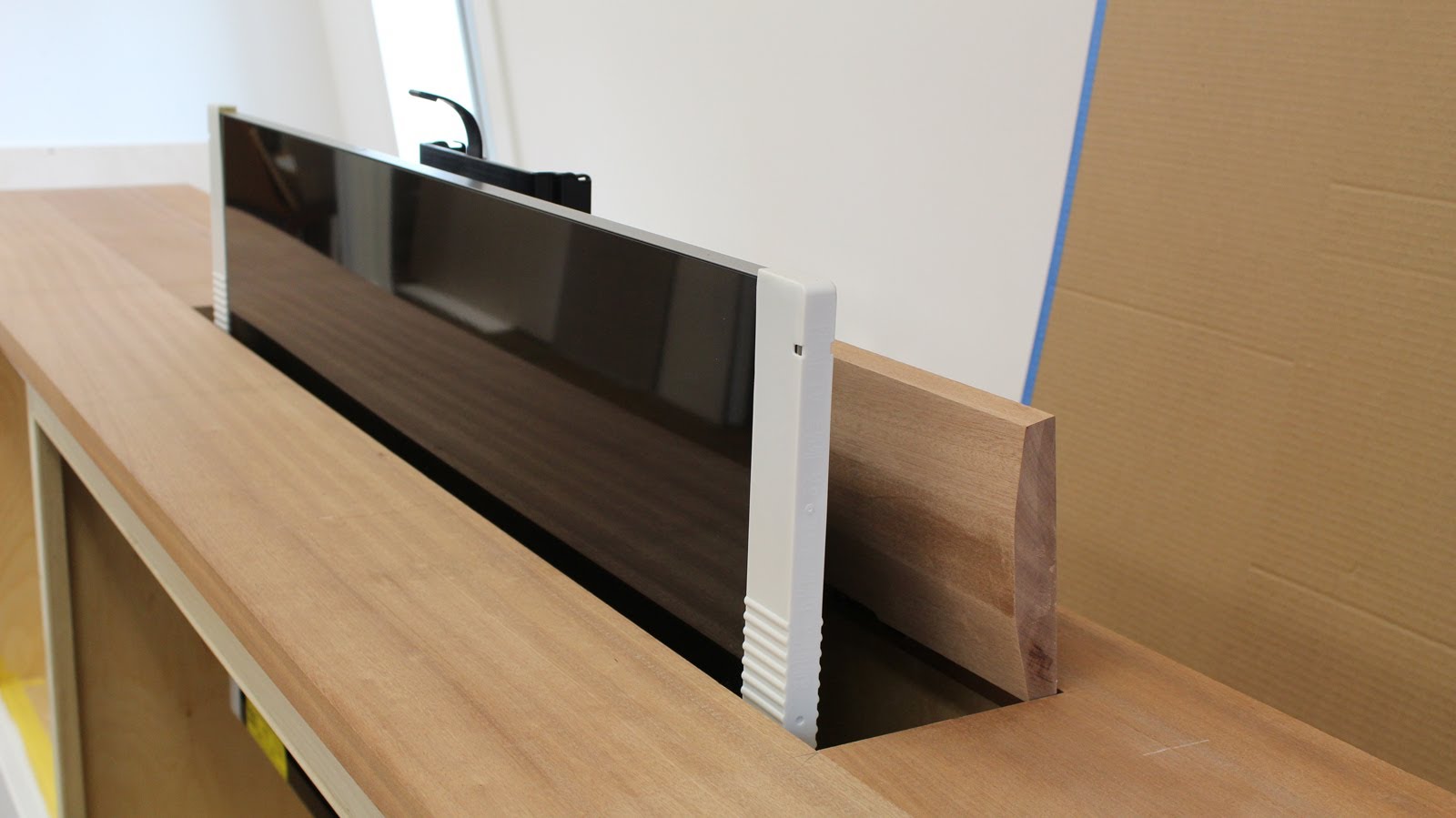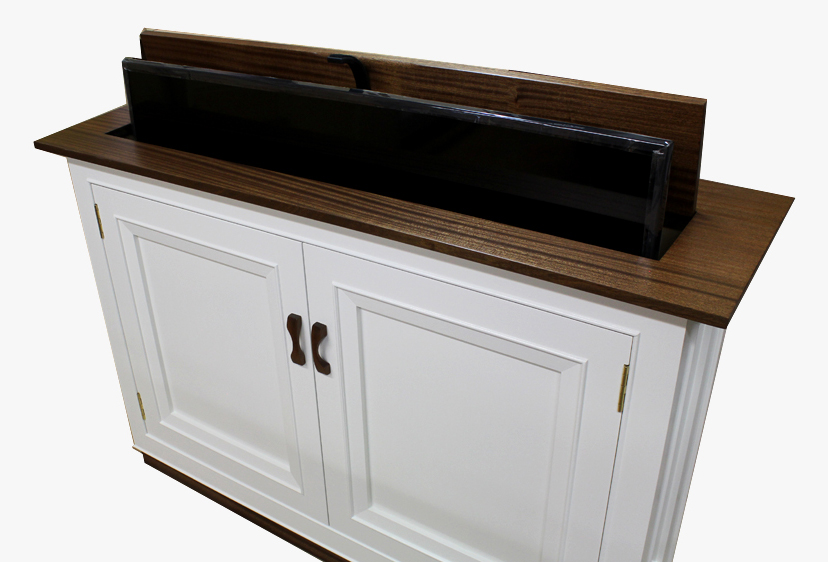Planning and Design

Embarking on the journey to build your own TV lift cabinet requires meticulous planning and a keen eye for design. This section delves into the essential considerations that will shape your project, from choosing the right type of cabinet to ensuring it seamlessly integrates into your space.
Types of TV Lift Cabinets
The first step in your planning is to explore the diverse range of TV lift cabinets available. Understanding their unique features and benefits will guide you towards the perfect fit for your needs.
- Electric Lift Cabinets: These cabinets offer the most convenient and effortless experience. With a simple press of a button, your TV gracefully rises from its hidden compartment, ready for entertainment. Their motorized mechanisms provide smooth and reliable operation, making them ideal for larger televisions.
- Gas-Spring Lift Cabinets: This type of cabinet relies on the power of gas springs to elevate the TV. They offer a more budget-friendly option compared to electric models, while still providing a smooth and controlled lift. Gas-spring lift cabinets are suitable for lighter televisions and can be a good choice for DIY projects.
- Manual Lift Cabinets: As the name suggests, these cabinets require manual effort to raise and lower the TV. While they offer the most affordable option, they may not be ideal for larger televisions or those who prefer a hands-free experience. However, they can be a viable choice for smaller screens or if you enjoy a bit of hands-on involvement.
Choosing the Right Size and Style
The size and style of your TV lift cabinet are crucial for both functionality and aesthetics. Consider the following factors:
- TV Size: The cabinet must accommodate your television’s dimensions, including its width, height, and depth. Ensure there is enough space for the TV to rise and fall freely without any obstruction.
- Room Size: The cabinet should be proportionate to the room’s size, avoiding overwhelming or cramped spaces. It’s important to visualize the cabinet’s placement and how it will blend with the existing furniture and decor.
- Style: The cabinet’s style should complement the overall aesthetic of the room. Consider your existing furniture, color scheme, and personal preferences. Modern, traditional, or minimalist styles can all be incorporated into TV lift cabinet designs.
Designing for Functionality and Decor
A well-designed TV lift cabinet goes beyond aesthetics, seamlessly integrating functionality and style.
- Storage: Consider incorporating storage solutions into your cabinet design. Shelves, drawers, or compartments can help organize media equipment, remote controls, and other accessories.
- Cable Management: A well-designed cabinet will include discreet cable management systems. This ensures that wires and cords are hidden from view, maintaining a clean and organized appearance.
- Accessibility: Ensure the TV lift mechanism is easy to use and accessible. The control buttons should be conveniently placed and clearly labeled.
- Measurements: Begin by taking accurate measurements of your TV and the intended space for the cabinet. Consider the height of the TV when raised and lowered, as well as the surrounding walls and furniture.
- Material Selection: Choose materials that are both durable and aesthetically pleasing. Wood, metal, and glass are popular choices for TV lift cabinets, offering a variety of finishes and textures.
- Budget Considerations: Set a realistic budget for your project. Consider the cost of materials, labor, and any specialized components, such as the lift mechanism.
- Design Concept: Sketch or create a visual representation of your TV lift cabinet design. This will help you visualize the final product and make adjustments as needed.
- Use a measuring tape and pencil to mark the wood for cutting.
- Cut the wood to the exact dimensions you have planned.
- Use wood glue and screws to join the pieces of wood together.
- Clamp the pieces together while the glue dries to ensure a strong bond.
- Choosing the Right Mechanism: Select a TV lift mechanism that can support the weight of your TV and is compatible with the cabinet size. Consider the lift speed, travel distance, and noise level when making your choice.
- Mounting the Mechanism: The lift mechanism usually comes with instructions for mounting it to the cabinet. Carefully follow these instructions. Ensure the mechanism is level and secure before proceeding.
- Testing the Mechanism: Once the mechanism is installed, test it to make sure it works correctly. Make sure the TV lifts smoothly and stops at the desired height.
- Power Connection: The mechanism will typically have a power cord that needs to be plugged into a wall outlet.
- Remote Control Connection: Some mechanisms use a wireless remote control, while others use an infrared remote. Make sure you understand how to connect the remote to the mechanism.
- Attaching the Mounting Plate: Follow the instructions provided with the lift mechanism to attach the mounting plate to the TV. Ensure the mounting plate is securely fastened to the TV.
- Securing the TV to the Mechanism: The mounting plate will then attach to the lift mechanism. Make sure the TV is properly aligned and secure before operating the lift.
- Shelves: Incorporate adjustable shelves within the cabinet to accommodate components like gaming consoles, media players, or receivers.
- Drawers: Integrate drawers for storing remote controls, cables, or other small items, keeping them neatly concealed.
- Hidden Compartments: Design hidden compartments within the cabinet for valuable items or discreetly storing cables and wires.
- Accent Lighting: Install LED strips behind the TV or within the cabinet to create a subtle glow, highlighting the cabinet’s design and adding a touch of sophistication.
- Task Lighting: Include reading lamps or adjustable spotlights to illuminate the surrounding area, providing sufficient light for reading or other activities.
- Integrated Lighting: Consider integrating lighting into the cabinet’s design, such as using illuminated shelves or incorporating ambient lighting into the base.
- Speaker Integration: Conceal speakers within the cabinet’s sides or back, creating a surround-sound effect without cluttering the room.
- Subwoofer Placement: Design a compartment for a subwoofer, enhancing the bass response and creating a truly immersive audio experience.
- Wireless Connectivity: Integrate wireless technology for seamless connectivity with your TV and other devices, eliminating the need for unsightly cables.
- Paint: Apply a coat of paint to match your décor, choosing from a wide range of colors and finishes to create a cohesive look.
- Stain: For a natural and elegant finish, use wood stain to highlight the grain and texture of the cabinet’s wood.
- Decorative Accents: Enhance the cabinet’s aesthetic with decorative elements such as hardware, moldings, or decorative panels, adding a touch of personalization.
- Mechanism Malfunction: If the TV lift mechanism malfunctions, check for obstructions, worn-out parts, or loose connections. Contact a qualified technician for repairs.
- Electrical Problems: Inspect wiring and connections for any loose or damaged parts. Ensure proper grounding and consult an electrician for any electrical issues.
- Noise During Operation: A slight humming noise is normal, but excessive noise could indicate a problem. Check for loose parts or worn-out bearings and seek professional assistance if needed.
- Weight Limits: Never exceed the cabinet’s weight limit, as this could damage the lift mechanism or cause the TV to fall. Ensure the TV and any other items placed on the cabinet are within the specified weight limit.
- Proper Installation: Ensure the cabinet is properly installed according to the manufacturer’s instructions. Seek professional assistance if you’re unsure about any aspect of the installation process.
- Children and Pets: Keep children and pets away from the cabinet when it’s in operation. Secure the cabinet to prevent accidental movement or tipping.
Planning and Design Steps
The planning and design process for your TV lift cabinet is a systematic approach that ensures a successful outcome.
Building and Installation: How To Make Your Own Tv Lift Cabinet

Now that you have your design finalized, it’s time to bring your TV lift cabinet to life! This section will guide you through the construction process, step by step, from cutting and assembling the cabinet to installing the lift mechanism and wiring it up.
Cutting and Assembling the Cabinet
The first step is to cut the wood for your cabinet according to your design. Use a circular saw or table saw for precise cuts. Ensure you have the correct tools and safety gear, such as gloves, safety glasses, and a dust mask.
Here are some tips for cutting and assembling your cabinet:
Once the cabinet is assembled, sand it down to smooth out any rough edges. You can then apply a stain or paint to give your cabinet the desired finish.
Installing the TV Lift Mechanism
The TV lift mechanism is the heart of your TV lift cabinet. It’s responsible for raising and lowering the TV, and it needs to be installed carefully to ensure smooth operation.
Wiring the TV Lift Mechanism
The TV lift mechanism needs to be connected to a power source and a remote control. The wiring process will vary depending on the specific mechanism you’ve chosen.
Installing and Securing the TV
Once the lift mechanism is installed and wired, you can install your TV. Most TV lift mechanisms have a mounting plate that attaches to the back of the TV.
Customization and Enhancements

The foundation of your TV lift cabinet is built, but now it’s time to add your personal touch, transforming it from a functional structure to a statement piece that seamlessly integrates into your living space. This section delves into creative ways to customize and enhance your TV lift cabinet, turning it into a multi-functional masterpiece.
Storage Compartments
Storage compartments are a practical addition, maximizing space and keeping your entertainment essentials organized.
Lighting Features
Lighting adds ambiance and functionality to your TV lift cabinet, enhancing the viewing experience and showcasing its design.
Integrated Sound Systems, How to make your own tv lift cabinet
Elevate your entertainment experience with a seamlessly integrated sound system.
Personalizing the Appearance
The appearance of your TV lift cabinet is a reflection of your style. Explore various options to personalize its look.
Troubleshooting and Maintenance
While TV lift cabinets are generally reliable, there are some common issues that may arise.
Safety Considerations
Operating a TV lift cabinet safely is crucial to prevent accidents.
How to make your own tv lift cabinet – Building your own TV lift cabinet can be a rewarding DIY project, especially if you want to create a truly personalized space. For inspiration, you might want to consider incorporating elements from oriental bedroom design ideas , which often feature sleek lines and minimalist aesthetics.
This can help you create a sophisticated and functional TV lift cabinet that complements your bedroom décor.
Building your own TV lift cabinet can be a fun DIY project, and it’s a great way to maximize space in your living room. When it comes to maximizing space, you can draw inspiration from tiny home bedroom storage ideas which often utilize clever solutions like hidden compartments and multi-functional furniture.
The same principles can be applied to your TV lift cabinet design, allowing you to incorporate storage space for other items while keeping your TV tucked away when not in use.